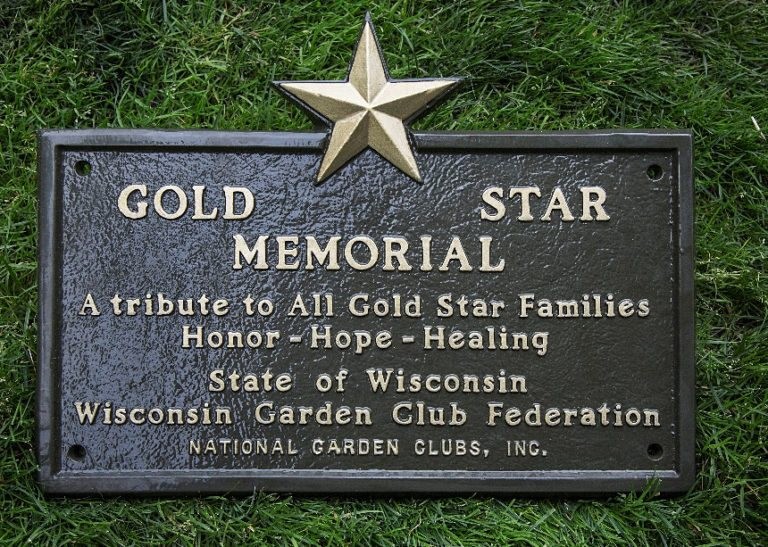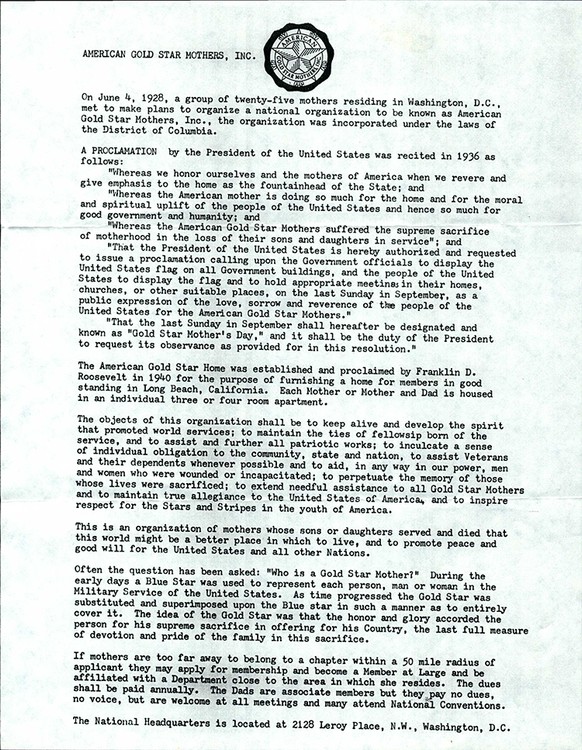Gold Star Memorial Garden
Introduction
Text-to-speech Audio
Images
Gold Star Memorial Plaque.

Letter of proclamation of Gold Star Mother’s Day as the last Sunday in September. The letter describes the formation of the Gold Star Mothers group, establishment of American Gold Star Home, and rules of the organization.

Backstory and Context
Text-to-speech Audio
The idea of the Gold Star as a symbol of loss during wartime can be traced to the first World War. During the Victorian era people wore Black to signify that they were in mourning. In 1917 after the United States entered World War I, Louise Bowen from Chicago suggested substituting the wearing of Black with that of a gold star. She proposed that the gold star better reflected that while sadness was undoubtedly felt at the loss, there was also a deep sense of pride in their loved one for the great and just cause of defending the United States. She also was concerned that as the deaths from the war began to accumulate, the sight of more and more people the streets in Black would dampen American’s morale and willingness to fight.
Men were encouraged to wear a gold star on an armband and women to hang a small gold star flag from the window of their homes. Called service flags, they could be seen in countless American windows by 1918. The service flag contained one blue star in a white rectangular field bordered with red for each person in the service. If a family lost a loved one, their flag showed a gold star superimposed over the blue.
Gold Star Mothers, beginning with Grace Darling Seibold, whose son had volunteered to fly during the first World War, would become a large, governmentally sanctioned service organization that exists to give comfort and community to mothers whose child had died. The organization also advocated on behalf of Gold Star Mothers and volunteers to do good in the veteran community. Today, there is an American Gold Star Families organization committed to education, advocacy and awareness, and support for those who have lost a loved one in service to their country.
Sources
“Blue Star Banner.” The American Legion. Accessed May 21, 2020. https://www.legion.org/troops/bluestar.
Budreau, Lisa M. "A Star of Recognition." In Bodies of War: World War I and the Politics of Commemoration in America, 1919-1933. New York: NYU Press, 2010. Accessed May 29, 2020. www.jstor.org/stable/j.ctt9qg107.18.
Powers, Rod. “United States Service Flags.” The Balance Careers. Accessed May 21, 2020. https://www.thebalancecareers.com/united-states-service-flags-are-back-in-style-3346204.
Stofflet, John. “New Gold Star Memorial honors Wisconsin Families who lost Loved Ones in Battle.” WMTV NBC15. Accessed May 24,2020. https://www.nbc15.com/content/news/goldstarmemorial-491507881.html.
Olson, Michael G. Gold Star Memorial Plaque. May 26, 2020, Madison.
Gold Star Mothers Inc. Dane County Chapter (Wis.) Records, 1984-2002. WVM Mss 629. Wisconsin Veterans Museum (Madison, Wis).
